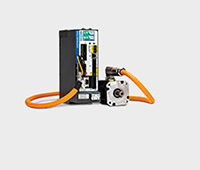
A gas-resistant resin was chosen for its ability to resist chemicals and high engine temperatures.
Hoffer Plastics is a custom injection molder with extensive capabilities in plastics processing.
A long-time customer approached the company with a dilemma: In order to meet the new EPA emission standards in California, they would have to build a new carburetor for its line of small engines for lawn mowers and other small lawn and garden equipment. This new carburetor required a more complex design than their current small engine carburetors to meet the new stringent emission laws.
Engineers decided to convert the company’s current aluminum carburetor used on industrial applications to plastic, giving them a way to increase output, reduce costs and provide a more high-functioning part.
Engineers began by assisting the customer with manufacturing considerations that would be required to convert their current aluminum part to a plastic component. While it may sound like an easy conversion, there were challenges. The metal carburetor’s complex geometry was formerly created through a die casting process and then machined. But the plastic carburetor would be created as a single component through injection molding, a much different process than previously used.
Collaboration between the company and customer was critical to redesigning a metal component to accommodate a molded plastic part. Engineers worked with the customer and a local mold manufacturing company to design and build the single-cavity prototype mold. This phase of the project required numerous iterations as changes were required to resolve dimensional issues to get a functional mold and moldable part. Additionally, the molds had to be capable of molding this part repeatedly and consistently to produce 10 million units annually.
Considerations had to be given to critical design factors such as wall thickness, gating, material flow patterns and ejection. To assist with the evaluation of these factors, a Moldex3D analysis was performed to validate gate placement and ejection based on the geometry of the part and the material flow.
Another challenge was the “bowl contouring.” The carburetor has just shy of 500 dimensions, with several dozen of those being critical dimensions that require checking with a CMM. The concentricity and bowl diameters have to be held in manufacturing every day and for every part.
Once the prototype mold was completed and the production mold design approved, the customer moved forward with a multi-million dollar investment in the automation required at their facility for the assembly of the engines’ carburetors. The carburetor is one part of a very complex multi-part assembly.
Carburetors from the prototype tool underwent testing at the customer’s manufacturing facility to ensure that the plastic carburetor met performance specifications. When it passed, the customer gave the go-ahead on the two-cavity production tool, the first of multiple molds required to handle the annual part volumes the customer needed. Tooling challenges included the complex ejection system and a specially designed hot runner system that was needed due to the location of the gating.
Production quality was ensured because of in-mold transducers using E-Dart technology. This specialized technique monitors cavity pressure during the mold filling stage to ensure consistent repeatability of part dimensions. Mold qualification and process validation took months to perform, and developing the optimal molding process required numerous rounds of sampling.
The result was the successful development of a thermoplastic carburetor that met the customer’s needs. The metal-to-plastic conversion helped reduce costs while helping to optimize the customer’s supply chain and meet the environmental requirements needed for the new regulations in California.
The company has multiple production cells running to produce the carburetors, and to date has shipped over 8 million parts with zero defects. Additionally, preventative and predictive maintenance allowed the company to reduce tool maintenance from every 48 hours needed initially to every 400 hours.
Hoffer Plastics
hofferplastics.com
Filed Under: Materials • advanced, MOTION CONTROL





Tell Us What You Think!